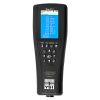Thermo Orion Star A329 Portable pH/ISE/Conductivity/RDO/DO Meter
Features
- Capable of reading eleven parameters with Orion electrodes/RDO optical probe
- AUTO-READ function alerts user and locks stable readings on backlit LCD screen
- USB and RS-232 ports allow easy data transfer of up to 5000 time-stamped data points
- Free ground shipping
- Expedited repair and warranty service
- Lifetime technical support
- More
The waterproof, battery-operated Thermo Orion Star A329 portable pH/ISE/conductivityRDO/DO meter stands up to the most demanding field applications to deliver the most comprehensive package and advanced performance of any portable meter. Four AA batteries, included with purchase of the A329, provide over 800 hours of continuous operation so the instrument is ready when it's needed, where it's needed. The meter displays reliable pH, mV, RmV, ISE, conductivity, TDS, salinity, resistivity, dissolved oxygen concentration, dissolved oxygen percent saturation and temperature readings on a large, backlit LCD screen and automatically locks in stable readings. Both Orion polarographic and RDO optical DO probes are compatible with the meter, as well as the extensive line of Orion pH, ISE, and conductivity electrodes.
Orion Star A320 series portable meters provide the largest storage capacity available for time-stamped data points, which can be conveniently uploaded to a PC through the meter's USB and RS-232 ports. Automatic or 1 to 5 point manual pH/ISE and conductivity calibration and a variety of DO calibration options make instrument setup simple, while icons provide quick updates on battery life, electrode status and calibration information. The simple button layout and on-screen messages also assist with calibration and explain setup menu choices.
- AUTO-READ function alerts user and locks on-screen readings when stable
- Up to 5 point pH/ISE and conductivity calibration with calibration editing
- Automatic recognition of USA/NIST and DIN buffers
- Advanced ISE features such as timed end point, linear point-to-point, non-linear selectable auto-blank and low-concentration range stability
- Selectable cell constant for use with 2- or 4-cell conductivity cells
- Selectable reading reference temperatures of 5, 10, 15, 20 or 25 C to increase conductivity accuracy
- Includes standard practical salinity curve for salinity readings, linear or ISO/EN 27888 curves for TDS
- Accepts Orion polarographic and RDO optical probes
- Automatic temperature compensation, manual salinity compensation and automatic or manual barometric pressure compensation
- DO calibration options include water-saturated air, air-saturated water, Winkler titration and zero point
- Easy to recall calibration slope data for procedure checks
- Non-volatile memory holds up to 5000 data points
- USB and RS-232 ports to upload data and update included data analysis software
- Universal power supply or battery power option
- Includes (4) AA batteries to provide over 800 hours of operation
- Universal power adapter (sold separately) runs meter on AC power
- Multilanguage interface supports English, Spanish, French, Italian, German and Chinese
- IP67-rated waterproof housing (can be immersed up to one hour with no water incursion)
- 3 year meter warranty
- pH
- Range: -2.00 to 20.00
- Resolution: 0.1, 0.01, 0.001
- Relative Accuracy: +/-0.002
- Calibration Points: Up to 5
- Calibration Editing: Yes
- mV/RmV
- Range: +/-2000.0 mV
- Resolution: 0.1 mV
- Relative Accuracy: +/-0.2mV or 0.05%, whichever is greater
- EH ORP Mode: Yes
- ISE
- Range: 0 to 19999
- Resolution: Up to 3 significant figures
- Relative Accuracy: +/-0.2 mV or +/-0.05% of reading, whichever is greater
- Units: ppm, M, mg/L, %, ppb, none
- Calibration Points: Up to 5
- Calibration Editing: Yes
- Calibration Features: Timed end point, linear point to point, non-linear selectable auto-blank, low concentration range stability
- Conductivity
- Range: 0.001 uS to 3000 mS
- Resolution: Min 0.001 uS or 4 significant figures
- Relative Accuracy: 0.5% reading +/-1 digit
- Reference: 5, 10, 15, 20, 25 C (default)
- Compensation: Linear (0.0 to 10.0 %/C), nLn, nLFu, EP
- Compatible Cell Constants: 0.001 to 199.9
- Number of Calibration Points: Up to 5
- Calibration Editing: Yes
- Resistivity
- Range: 2 ohm to 100 meg-ohm
- Resolution: 2 ohm-cm
- Relative Accuracy: 0.5% reading +/-1 digit
- Salinity
- Type: Practical salinity or natural sea water
- Range: 0.01 to 80.0 ppt NaCl equivalent; 0.01 to 42 ppt practical
- Resolution: 0.01
- Relative Accuracy: +/-0.1
- TDS
- Range: 0 to 200 ppt
- Resolution: 4 significant figures
- Relative Accuracy: 0.5% reading +/-1 digit
- TDS Factor Range: Linear 0.01 to 10.00
- Dissolved Oxygen Polarographic Concentration (% Sat)
- Range: 0 to 90 mg/L (0 to 600 %)
- Resolution: 0.01, 0.1 (0.1,1)
- Relative Accuracy: +/-0.2 (+/-2 %)
- Dissolved Oxygen RDO Concentration (% Sat)
- Range: 0 to 50 mg/L (0 to 500 %)
- Resolution: 0.01, 0.1 (0.1,1)
- Relative Accuracy: +/-0.1 up to 8 mg/L;+/-0.2 from 8 to 20 mg/L; 10% of reading above 20 mg/L(+/-2 %)
- Dissolved Oxygen
- Manual Barometric Pressure Compensation: 450.0 to 850.0 mm Hg
- Manual Salinity Factor Correction: 0 to 45 ppt
- Calibration Features: Water-saturated air, air-saturated water, manual (Winkler) and zero point
- Sensor type: Polarographic or RDO
- Temperature
- Range: -5 to 105 C
- Resolution: 0.1
- Relative Accuracy: +/-0.1 C
- Offset Calibration: 1 point
- Datalogging
- Number of Points: 5000 with time and date stamp
- Log Function: Manual, ready (AUTO-READ), timed
- Log Edit: Delete individual points, group of points or all
- General
- Display: Backlit LCD
- Inputs: pH Electrode - BNC, ATC Probe - 8-pin mini-DIN
- Outputs: RS-232, USB
- Power Adapter: Universal AC, 100-240 VAC
- Battery Power: 4 AAs, 800 hrs life
- Environmental Requirements: 5 to 45 C and 5 to 85% relative humidity, non-condensing
- Regulatory and Safety: CE, TUV 3-1, FCC Class A
- IP Rating: IP67, waterproof
- Warranty: 36 months (from date of purchase)
In The News
Choosing The Right Thermo Portable For Your Project
With so many options in Thermo Scientific’s Orion Star A line, it can be difficult to narrow down which meter will best fulfill a project’s needs. One easy way to rule out some meters is by considering application type. For projects that rely largely on collecting samples in the field, a portable meter is clearly the way to go. But there’s still a handful of meters to choose from. To simplify making the right choice, we spoke with Ricki Hartwell, the global product manager for Thermo Scientific’s Orion Laboratory and Field Instruments. She recently shared her tips on choosing the right Thermo benchtop. Let’s take a look at her recommendations for selecting the right portable meter.
Read MoreOcean acidification: University of Washington's giant plastic bags help control research conditions
With oceans becoming more acidic worldwide, scientists are getting creative in designing experiments to study them. For example, one group at the University of Washington is using giant plastic bags to study ocean acidification. Each bag holds about 3,000 liters of seawater and sits in a cylinder-like cage for stability. The group at UW, made up of professors and students, is controlling carbon dioxide levels in the bags over a nearly three-week period, during which they are looking at the effects of increased acidity on organisms living near the San Juan Islands. “These mesocosms are a way to do a traditional experiment you might do in a lab or classroom,” said Jim Murray, professor of oceanography at the University of Washington.
Read MoreNOAA Alaska buoy network to monitor North Pacific ocean acidification
National Oceanic and Atmospheric Administration scientists detected signs of ocean acidification in the waters that hold the vulnerable and valuable fisheries of the North Pacific off the coast of Alaska, but they only had a snapshot of the action. “We know that in this place were important commercial and subsistence fisheries that could be at risk from ocean acidification,” said Jeremy Mathis, a NOAA Pacific Marine Environmental Laboratory researcher and professor at the University of Alaska Fairbanks. To understand how ocean acidification affects the North Pacific, NOAA scientists created a mooring network that collects constant in situ data on parameters contributing to acidification. They hope it will reveal seasonal trends and patterns left out by their snapshots.
Read More





















































